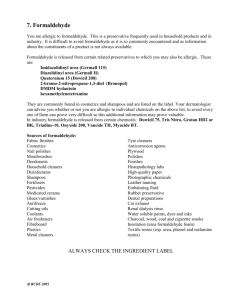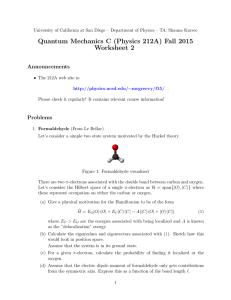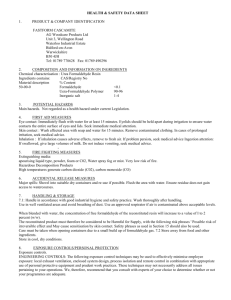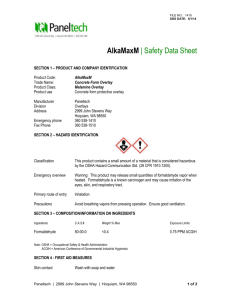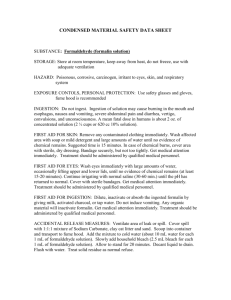Document 12682421
advertisement
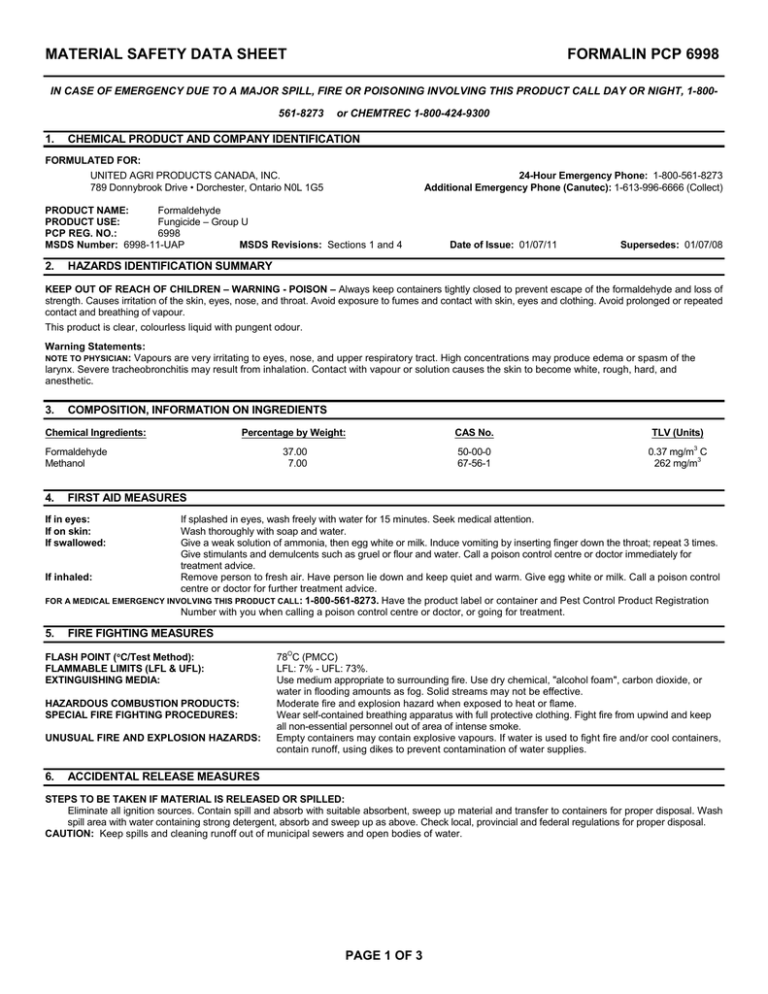
MATERIAL SAFETY DATA SHEET FORMALIN PCP 6998 IN CASE OF EMERGENCY DUE TO A MAJOR SPILL, FIRE OR POISONING INVOLVING THIS PRODUCT CALL DAY OR NIGHT, 1-800561-8273 1. or CHEMTREC 1-800-424-9300 CHEMICAL PRODUCT AND COMPANY IDENTIFICATION FORMULATED FOR: UNITED AGRI PRODUCTS CANADA, INC. 789 Donnybrook Drive • Dorchester, Ontario N0L 1G5 24-Hour Emergency Phone: 1-800-561-8273 Additional Emergency Phone (Canutec): 1-613-996-6666 (Collect) PRODUCT NAME: Formaldehyde PRODUCT USE: Fungicide – Group U PCP REG. NO.: 6998 MSDS Number: 6998-11-UAP MSDS Revisions: Sections 1 and 4 2. Date of Issue: 01/07/11 Supersedes: 01/07/08 HAZARDS IDENTIFICATION SUMMARY KEEP OUT OF REACH OF CHILDREN – WARNING - POISON – Always keep containers tightly closed to prevent escape of the formaldehyde and loss of strength. Causes irritation of the skin, eyes, nose, and throat. Avoid exposure to fumes and contact with skin, eyes and clothing. Avoid prolonged or repeated contact and breathing of vapour. This product is clear, colourless liquid with pungent odour. Warning Statements: NOTE TO PHYSICIAN: Vapours are very irritating to eyes, nose, and upper respiratory tract. High concentrations may produce edema or spasm of the larynx. Severe tracheobronchitis may result from inhalation. Contact with vapour or solution causes the skin to become white, rough, hard, and anesthetic. 3. COMPOSITION, INFORMATION ON INGREDIENTS Chemical Ingredients: Percentage by Weight: CAS No. TLV (Units) 37.00 7.00 50-00-0 67-56-1 0.37 mg/m C 3 262 mg/m Formaldehyde Methanol 4. 3 FIRST AID MEASURES If in eyes: If on skin: If swallowed: If splashed in eyes, wash freely with water for 15 minutes. Seek medical attention. Wash thoroughly with soap and water. Give a weak solution of ammonia, then egg white or milk. Induce vomiting by inserting finger down the throat; repeat 3 times. Give stimulants and demulcents such as gruel or flour and water. Call a poison control centre or doctor immediately for treatment advice. If inhaled: Remove person to fresh air. Have person lie down and keep quiet and warm. Give egg white or milk. Call a poison control centre or doctor for further treatment advice. FOR A MEDICAL EMERGENCY INVOLVING THIS PRODUCT CALL: 1-800-561-8273. Have the product label or container and Pest Control Product Registration Number with you when calling a poison control centre or doctor, or going for treatment. 5. FIRE FIGHTING MEASURES FLASH POINT (°C/Test Method): FLAMMABLE LIMITS (LFL & UFL): EXTINGUISHING MEDIA: HAZARDOUS COMBUSTION PRODUCTS: SPECIAL FIRE FIGHTING PROCEDURES: UNUSUAL FIRE AND EXPLOSION HAZARDS: 6. O 78 C (PMCC) LFL: 7% - UFL: 73%. Use medium appropriate to surrounding fire. Use dry chemical, "alcohol foam", carbon dioxide, or water in flooding amounts as fog. Solid streams may not be effective. Moderate fire and explosion hazard when exposed to heat or flame. Wear self-contained breathing apparatus with full protective clothing. Fight fire from upwind and keep all non-essential personnel out of area of intense smoke. Empty containers may contain explosive vapours. If water is used to fight fire and/or cool containers, contain runoff, using dikes to prevent contamination of water supplies. ACCIDENTAL RELEASE MEASURES STEPS TO BE TAKEN IF MATERIAL IS RELEASED OR SPILLED: Eliminate all ignition sources. Contain spill and absorb with suitable absorbent, sweep up material and transfer to containers for proper disposal. Wash spill area with water containing strong detergent, absorb and sweep up as above. Check local, provincial and federal regulations for proper disposal. CAUTION: Keep spills and cleaning runoff out of municipal sewers and open bodies of water. PAGE 1 OF 3 MATERIAL SAFETY DATA SHEET 7. FORMALIN PCP 6998 HANDLING AND STORAGE HANDLING: STORAGE: Wash hands before eating, drinking, chewing gum, using tobacco or using the toilet. Remove clothing immediately if pesticide gets inside. Then wash thoroughly and put on clean clothing. Remove PPE immediately after handling this product. Wash the outside of gloves before removing. As soon as possible, wash thoroughly and change into clean clothing. O Store in original container only. Do not store below 15 C as precipitation may occur. Keep container tightly closed when not in use. Store away from seeds, fertilizer, plants, and foodstuffs. Do not contaminate water, food or feed by storage or disposal. Personal Protective Equipment: Applicators and other handlers must wear: long sleeved shirt and long pants, wear a suitable NIOSH/MSHA approved respirator with organic vapour cartridges or wear self-contained breathing apparatus to prevent inhalation of gas fumes, rubber or chemicalresistant gloves, rubber boots plus socks, and protective eyewear. Follow manufacturer’s instructions for cleaning and maintaining PPE. If no such instructions for washables, use detergent and hot water. Keep and wash PPE separately from other laundry. After each day of use, clothing or PPE must no be reused until it has been cleaned. 8. EXPOSURE CONTROLS / PERSONAL PROTECTION ENGINEERING CONTROLS: RESPIRATORY PROTECTION: EYE PROTECTION: SKIN PROTECTION: Work in well-ventilated area. If vapours are too strong, use mechanical ventilation. If vapours or mists become excessive, wear a NIOSH approved pesticide respirator with organic vapour cartridges. Chemical splash goggles, shielded safety glasses, or full-face shield if splashing is likely to occur. Wear protective clothing: long-sleeved shirts and pants, apron, chemical-resistant rubber boots and socks. Wear rubber or chemical-resistant gloves. Formaldehyde Methanol 9. OSHA PEL 8 hr TWA 0.75 ppm 3 260 mg/m ACGIH TLV-TWA 3 0.37 mg/m C (Ceiling) 200 ppm (Skin) PHYSICAL AND CHEMICAL PROPERTIES APPEARANCE AND ODOUR: Clear, colourless liquid with pungent odour. SOLUBILITY: Infinite SPECIFIC GRAVITY (Water = 1): 1,08 g/ml BULK DENSITY: 1,08 kg/L. pH: 3.5 – 4.5 O VAPOR PRESSURE: 40 mm Hg BOILING POINT: ~100 C PERCENT VOLATILE (by volume): Not established EVAPORATION RATE (Butyl Acetate = 1): Similar to water Note: These physical data are typical values based on material tested but may vary from sample to sample. Typical values should not be construed as a guaranteed analysis of any specific lot or as specification items. 10. STABILITY AND REACTIVITY STABILITY: Formaldehyde solutions may self-polymerize to form paraformaldehyde which precipitates. CONDITIONS TO AVOID: Extreme heat or extreme cold. INCOMPATIBILITY: Strong oxidizing agents, caustics, strong alkalies, isocyanates, anhydrides, oxides, and inorganic acids. Formaldehyde reacts with hydrochloric acid to form the potent carcinogen, bis-chloromethyl ether. Formaldehyde reacts with nitrogen dioxide, nitromethane, perchloric acid and aniline, or peroxyformic acid to yield explosive compounds. A violent reaction occurs when formaldehyde is mixed with strong oxidizers. HAZARDOUS DECOMPOSITION PRODUCTS: Oxygen from the air can oxidize formaldehyde to formic acid, especially when heated. Formic acid is corrosive. HAZARDOUS POLYMERIZATION: Will not occur. 11. TOXICOLOGICAL INFORMATION Acute Oral LD50 (rat): 800 mg/kg (Formaldehyde) Acute Dermal LD50 (rabbit): 540 mg/kg (Formaldehyde) Eye Irritation (rabbit): May cause mild irritation Skin Irritation (rabbit): Causes irritation Inhalation LC50 (rat): 250 ppm (4HR) Skin Sensitization (guinea pig): Sensitizer Carcinogenic Potential: OSHA lists Formaldehyde as a carcinogen; NTP lists Formaldehyde as NTP-R: Reasonably Anticipated To Be A Human Carcinogen; ACGIH lists Formaldehyde as TLV-A2: Suspected Human Carcinogen; IARC lists Formaldehyde as Carcinogenic to Humans; NIOSH lists Formaldehyde as a Potential occupational carcinogen, with no further categorization; EPA lists Formaldehyde as EPA-B1: Limited evidence of carcinogenicity from epidemiologic studies. 12. ECOLOGICAL INFORMATION Formaldehyde dissolves easily but does not last a long time in water. Most formaldehyde in the air breaks down during the day. The breakdown products of formaldehyde are formic acid and carbon monoxide. Formaldehyde does not build up in plants and animals. Do not contaminate water when disposing of equipment wash water. PAGE 2 OF 3 MATERIAL SAFETY DATA SHEET FORMALIN PCP 6998 13. DISPOSAL CONSIDERATIONS Do not reuse containers for any purpose. Refillable Container: For disposal, the container may be returned to the point of purchase (dealer/distributor). It must be refilled by the dealer/distributor with the same product. Container is recyclable, and is to be disposed of at a container collection site. Contact your local dealer/distributor for the location of the nearest collection site. Before taking container to the collection site: Triple or pressure-rinse the empty container, adding the rinsate to the spray tank. Make the empty container unsuitable for further use. If there is no container collection site in your area, dispose of the container in accordance with provincial requirements. For information on disposal of unused, unwanted product, contact the manufacturer or the provincial regulatory agency. Do not contaminate water, food, or feed by storage or disposal. 14. TRANSPORT INFORMATION CANADA TDG Shipping Description: FORMALDEHYDE SOLUTION, 8, UN2209, II, ERG GUIDE 132 U.S. DOT Shipping Description: 30 gallons and less: FORMALDEHYDE SOLUTION, 8, UN2209, II, ERG GUIDE 132 U.S. DOT Shipping Description: Greater than 30 gallons: RQ FORMALDEHYDE SOLUTION, 8, UN2209, II, ERG GUIDE 132 U.S. and Canada Surface Freight Classification: FORMALDEHYDE, LIQUID (NMFC 44530 SUB 2; CLASS: 60) IMDG: FORMALDEHYDE SOLUTION, 8, UN2209, II, ERG GUIDE 132 15. REGULATORY INFORMATION NFPA & HMIS Hazard Ratings: NFPA 3 4 0 SARA Hazard Notification/Reporting SARA Title III Hazard Category: HMIS Health Flammability Instability Immediate Delayed __Y__ __ Y __ 0 1 2 3 4 Least Slight Moderate High Severe Fire Reactive 3 4 0 H __Y__ __N__ Health Flammability Reactivity PPE Sudden Release of Pressure __N__ Reportable Quantity (RQ) under U.S. CERCLA: Formaldehyde (CAS: 50-00-0) 100 lbs. SARA, Title III, Section 313: Formaldehyde (CAS: 50-00-0) RCRA Waste Code: U122 CA Proposition 65: Not applicable 16. OTHER INFORMATION MSDS STATUS: Sections 1 and 4 revised PREPARED BY: Registrations and Regulatory Affairs REVIEWED BY: Environmental/ Regulatory Services Disclaimer and Limitation of Liability: This data sheet was developed from information on the constituent materials identified herein and does not relate to the use of such materials in combination with any other material or process. No warranty is expressed or implied with respect to the completeness or ongoing accuracy of the information contained in this data sheet, and UNITED AGRI PRODUCTS CANADA, INC. disclaims all liability for reliance on such information. This data sheet is not a guarantee of safety. Users are responsible for ensuring that they have all current information necessary to safely use the product described by this data sheet for their specific purpose. PAGE 3 OF 3
